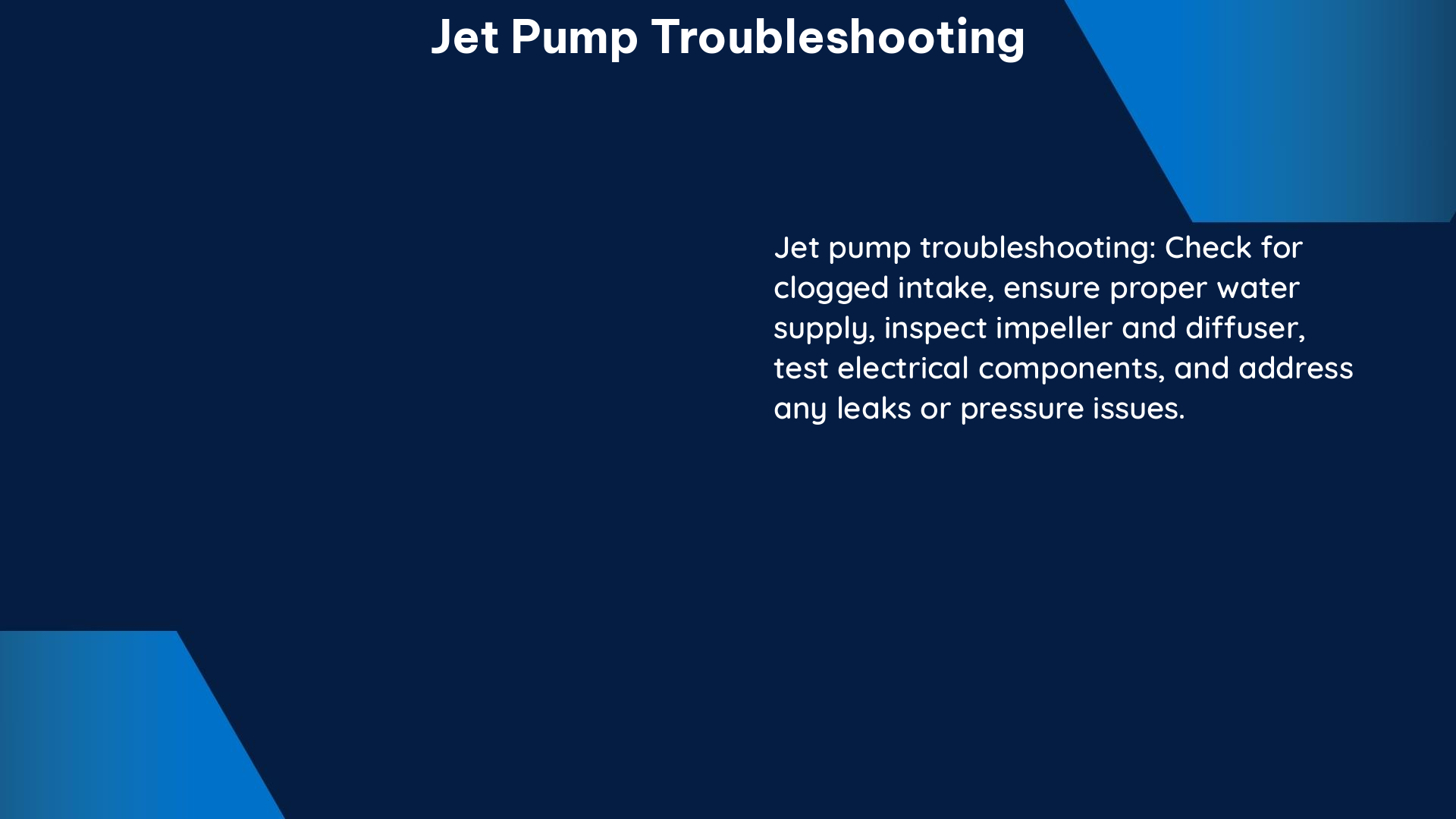Jet pumps are essential components in many water systems, but they can be prone to issues such as lost prime, clogged venturi, and pressure regulation problems. This guide provides a detailed overview of jet pump troubleshooting, focusing on quantifiable data, technical specifications, and DIY approaches to help you diagnose and resolve common jet pump issues.
Common Jet Pump Issues and Quantifiable Data
-
Lost Prime: This issue occurs when the pump loses its prime (suction) due to a lack of water in the suction line or a leak in the system. The pump may run but fail to deliver water. A common symptom is a noisy operation with no water flow. The loss of prime can be quantified by measuring the water level in the well or suction line, which should be at least 25 feet (7.6 meters) below the pump’s inlet to maintain sufficient suction.
-
Clogged Venturi: The venturi is a critical component in a jet pump that creates a pressure difference to draw water. If it becomes clogged with debris, the pump’s performance will decrease, resulting in lower water flow and pressure. The venturi’s diameter is typically between 0.5 to 1.5 inches (12.7 to 38.1 mm), and a clogged venturi can reduce the water flow by up to 50%.
-
Pressure Regulation Problems: Pressure regulators control the system pressure. If they are not set correctly or malfunction, the system pressure will be too high or too low, affecting the pump’s performance and potentially damaging the system. The ideal system pressure for a jet pump is typically between 30 to 50 PSI (2.1 to 3.4 bar), and a faulty pressure regulator can cause the pressure to deviate by 10 PSI (0.7 bar) or more.
Technical Specifications for Jet Pump Troubleshooting

-
Suction and Discharge Lines: Check the suction and discharge lines for leaks, kinks, or blockages. The suction line should be free of obstructions and have a minimum diameter of 1 inch (25.4 mm) to ensure adequate water flow. The discharge line should be the correct size, typically 1 to 1.5 inches (25.4 to 38.1 mm) in diameter, to handle the water flow and pressure.
-
Foot Valve and Check Valve: Inspect the foot valve and check valve for debris or damage. These components prevent backflow and maintain the prime. If they are damaged or clogged, the pump may lose its prime or not deliver sufficient water flow. The foot valve’s orifice diameter should be at least 0.75 inches (19.1 mm) to allow for proper water flow.
-
Pressure Regulator: Adjust the pressure regulator to the correct setting based on the system requirements, typically between 30 to 50 PSI (2.1 to 3.4 bar). If the regulator is faulty, replace it with a new one of the correct type and size, ensuring it can handle the maximum system pressure.
-
Venturi: Clean the venturi regularly to remove any debris or buildup. If the venturi is damaged, replace it with a new one of the correct size and type. The venturi’s diameter should match the pump’s specifications, typically ranging from 0.5 to 1.5 inches (12.7 to 38.1 mm).
-
Prime: Ensure the pump has sufficient prime (suction) by checking the water level in the well or suction line, which should be at least 25 feet (7.6 meters) below the pump’s inlet. If the water level is low, prime the pump using a priming tool or by manually adding water to the suction line.
DIY Jet Pump Troubleshooting
-
Check the Suction and Discharge Lines: Inspect the suction and discharge lines for any leaks, kinks, or blockages. Repair or replace any damaged or faulty components, ensuring the suction line diameter is at least 1 inch (25.4 mm) and the discharge line diameter is 1 to 1.5 inches (25.4 to 38.1 mm).
-
Inspect the Foot Valve and Check Valve: Remove the pump from the well or suction line and inspect the foot valve and check valve for debris or damage. Clean or replace any faulty components, ensuring the foot valve’s orifice diameter is at least 0.75 inches (19.1 mm).
-
Adjust the Pressure Regulator: Locate the pressure regulator and adjust it to the correct setting, typically between 30 to 50 PSI (2.1 to 3.4 bar), based on the system requirements. If the regulator is faulty, replace it with a new one of the correct type and size that can handle the maximum system pressure.
-
Clean the Venturi: Remove the pump from the well or suction line and clean the venturi to remove any debris or buildup. If the venturi is damaged, replace it with a new one of the correct size, typically ranging from 0.5 to 1.5 inches (12.7 to 38.1 mm) in diameter.
-
Prime the Pump: If the pump loses its prime, prime it using a priming tool or by manually adding water to the suction line. Ensure the water level in the well or suction line is at least 25 feet (7.6 meters) below the pump’s inlet to maintain sufficient suction.
Reference Links
- PuMP Blueprint Workshop – Performance Measure & KPI Training
- Deep well jet pump that will not build pressure – DoItYourself.com
- Dimensional Measurement of Centrifugal Pumps – KEYENCE.com

The lambdageeks.com Core SME Team is a group of experienced subject matter experts from diverse scientific and technical fields including Physics, Chemistry, Technology,Electronics & Electrical Engineering, Automotive, Mechanical Engineering. Our team collaborates to create high-quality, well-researched articles on a wide range of science and technology topics for the lambdageeks.com website.
All Our Senior SME are having more than 7 Years of experience in the respective fields . They are either Working Industry Professionals or assocaited With different Universities. Refer Our Authors Page to get to know About our Core SMEs.